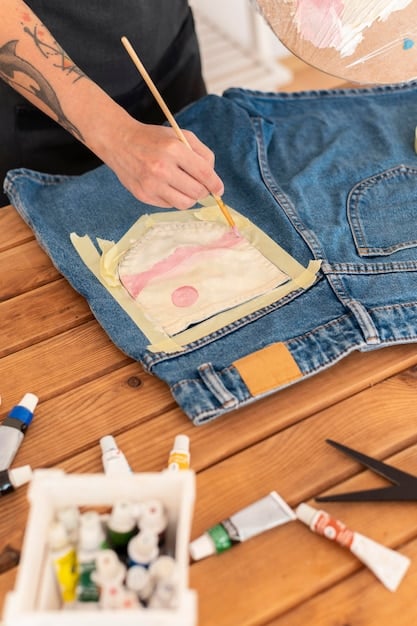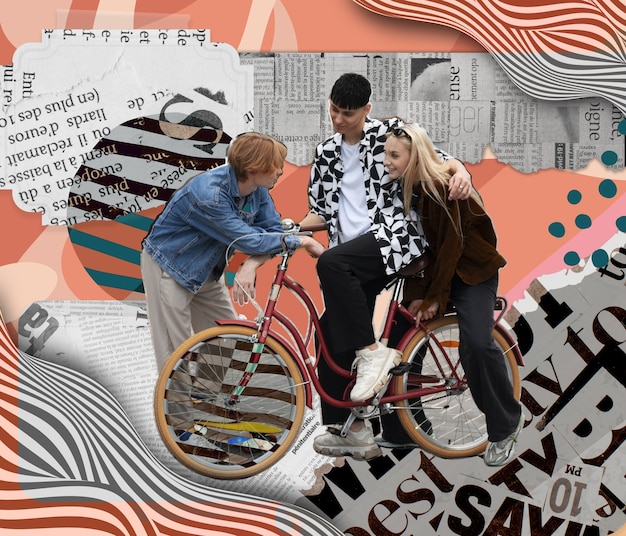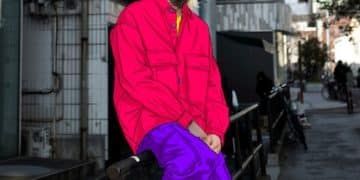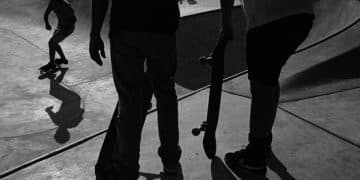DIY Streetwear: Customize Your Clothes for a Unique Style

DIY streetwear allows you to express your unique style by customizing clothing through various techniques like painting, embroidery, and repurposing, creating original pieces that reflect your personality.
Ready to transform your wardrobe and stand out from the crowd? DIY streetwear is all about expressing your individuality through customized clothing. Let’s dive into how you can create unique pieces that reflect your personal style and make a statement.
Why DIY Streetwear is the Ultimate Style Statement
Streetwear has always been about individuality and self-expression. In recent years, the DIY ethos has permeated the scene, offering a way to stand out from the mass-produced trends. Customizing your clothes is not only a creative outlet but also a sustainable way to refresh your wardrobe.
Expressing Individuality
One of the biggest draws of DIY streetwear is the ability to express your unique personality. Instead of conforming to mainstream fashion, you can curate pieces that truly reflect your interests and style. Whether you’re into graphic designs, bold colors, or intricate patterns, DIY allows you to wear your passions.
Sustainable Fashion
DIY streetwear also aligns with the growing movement towards sustainable fashion. By repurposing old clothes, thrifting vintage finds, and giving new life to forgotten items, you’re reducing textile waste and contributing to a more eco-friendly approach to fashion. This conscious consumption adds another layer of meaning to your style.
Budget-Friendly
Customizing your clothes can be surprisingly budget-friendly. Instead of buying expensive new items, you can transform what you already own or find affordable pieces at thrift stores. With a few basic supplies and a bit of creativity, you can create high-impact looks without breaking the bank, making streetwear accessible to everyone.
Ultimately, DIY streetwear is more than just a trend; it’s a powerful statement of self-expression and sustainability. By embracing your creativity and adopting a DIY approach, you can create a wardrobe that is uniquely yours and reflects your values and lifestyle. This combination of personal style, sustainability, and affordability makes DIY streetwear an appealing trend for those looking to stand out.

Essential Techniques for Customizing Your Clothes
To embark on your DIY streetwear journey, it’s essential to learn the fundamental techniques that will help you transform your clothes. These techniques range from simple alterations to more intricate designs, offering a wide array of possibilities for customization.
Painting and Drawing
- Fabric paints are a great way to add bold designs and graphics to your clothes. Start with simple sketches and gradually move on to more complex artwork.
- Fabric markers are ideal for creating detailed patterns and outlines. They provide precision and control, perfect for intricate designs.
- Stencils offer a quick and easy way to create repeatable designs. Use them to add logos, letters, and geometric patterns to your streetwear.
Embroidery and Patchwork
Embroidery is a versatile technique that adds texture and dimension to your clothes. Whether you prefer hand embroidery or machine embroidery, the possibilities are endless.
- Hand embroidery allows for intricate and personalized designs. Experiment with different stitches to create unique textures and patterns.
- Patches are a fun and easy way to add character to your clothes. You can buy pre-made patches or create your own using fabric scraps and embroidery.
- Patchwork involves sewing together different fabric pieces to create a cohesive design. This technique is perfect for repurposing old clothes and creating one-of-a-kind pieces.
Repurposing and Upcycling
Repurposing and upcycling are sustainable ways to transform old clothes into new and stylish streetwear pieces. With a bit of creativity, you can give forgotten items a new lease on life.
- Cut and sew techniques can transform oversized garments into fitted pieces. Alter the sleeves, neckline, or hemline to create a more modern silhouette.
- Adding hardware like zippers, buttons, and studs can give your clothes an edgy look. Experiment with different placements and combinations to create unique designs.
- Screen printing is a more advanced technique that allows you to create professional-looking graphics on your clothes. While it requires specialized equipment, the results can be stunning.
Mastering these essential techniques opens up a world of possibilities for DIY streetwear customization. Whether you’re painting bold designs, adding intricate embroidery, or repurposing old clothes, these skills will help you create unique pieces that reflect your personal style and make a statement.
Finding Inspiration and Developing Your Style
Inspiration is all around us, and it’s crucial to tap into sources that resonate with your personal style. From art and music to nature and urban landscapes, draw inspiration from diverse areas and develop a distinct aesthetic for your DIY streetwear.
Exploring Art and Culture
Art and culture offer endless inspiration for DIY streetwear designs. Visit museums, galleries, and cultural events to explore different styles and techniques. Consider incorporating elements from your favorite artists, movements, or cultural traditions into your clothing.
- Street art and graffiti provide bold and graphic inspiration. Incorporate vibrant colors, bold lines, and dynamic compositions into your designs.
- Music and fashion often go hand in hand. Draw inspiration from your favorite bands, genres, and subcultures to create streetwear that reflects your musical taste.
- Traditional patterns and textiles offer a rich source of inspiration. Incorporate ethnic prints, tribal motifs, and cultural symbols into your clothing for a unique and meaningful touch.
Observing Street Style
Street style is a constantly evolving source of inspiration. Pay attention to what people are wearing in your city and around the world. Look for unique combinations, unexpected details, and emerging trends. Use social media, fashion blogs, and street style photography to stay up-to-date.
- Social media platforms like Instagram and Pinterest are excellent resources for finding DIY streetwear inspiration. Follow designers, influencers, and brands that align with your style.
- Fashion blogs and street style photography offer a curated collection of looks from around the world. Study these sources to identify emerging trends and unique styling ideas.
- Attend local fashion events and street style gatherings to get a firsthand look at the latest trends. Engage with other fashion enthusiasts and exchange ideas.
Creating Mood Boards
Mood boards are a powerful tool for visualizing your style and bringing your ideas to life. Create a digital or physical mood board with images, colors, textures, and words that inspire you. Use your mood board as a reference point when designing your DIY streetwear pieces.
- Gather images of your favorite clothing items, accessories, and design elements. Include samples of fabrics, paints, and other materials you plan to use.
- Experiment with different color palettes and textures. Consider how these elements work together to create a cohesive and visually appealing design.
- Add words and phrases that capture the essence of your style. These can be quotes, song lyrics, or personal mantras that resonate with you.

Developing your unique style is an ongoing process of exploration and experimentation. By finding inspiration in art, culture, street style, and personal experiences, you can curate a distinct aesthetic that sets you apart from the crowd. Embrace your creativity, trust your instincts, and let your imagination guide you on your DIY streetwear journey.
Tools and Materials You’ll Need
To bring your DIY streetwear ideas to life, you’ll need a collection of essential tools and materials. These supplies will help you execute your designs with precision and creativity, ensuring high-quality results.
Basic Sewing Supplies
Even if you’re not an experienced sewer, having basic sewing supplies on hand is essential for DIY streetwear customization. These tools will help you make alterations, repairs, and embellishments to your clothing.
- A sewing machine is a valuable investment for more ambitious projects. Look for a model that can handle a variety of fabrics and stitches.
- Hand sewing needles are essential for small repairs and intricate designs. Keep a variety of sizes and types on hand.
- Thread in various colors is necessary for matching and coordinating with your fabrics. Invest in high-quality thread that won’t break easily.
Fabric Painting and Drawing Supplies
If you plan to incorporate painting and drawing into your DIY streetwear designs, you’ll need a range of specialized supplies. These materials will help you create vibrant and long-lasting artwork on your clothing.
- Fabric paints are specifically designed to adhere to fabric and withstand washing. Choose a variety of colors and finishes, such as matte, glossy, and metallic.
- Fabric markers are ideal for creating detailed patterns and outlines. Look for markers with fine tips and fade-resistant ink.
- Stencils are a quick and easy way to create repeatable designs. You can buy pre-made stencils or create your own using cardboard or plastic sheets.
Embroidery and Patchwork Supplies
For adding texture and dimension to your DIY streetwear, embroidery and patchwork supplies are essential. These tools will help you create intricate designs and unique embellishments.
- Embroidery floss in various colors is necessary for hand embroidery projects. Choose high-quality floss that won’t fray or fade easily.
- Embroidery hoops are essential for keeping fabric taut while you stitch. Look for hoops in different sizes and materials.
- Fabric scraps in various colors and patterns are perfect for creating patches and patchwork designs. Collect scraps from old clothes, thrift stores, or fabric stores.
Having the right tools and materials on hand can make all the difference in your DIY streetwear projects. Invest in high-quality supplies that will help you execute your designs with precision and creativity. With a well-stocked toolkit, you’ll be ready to tackle any customization challenge.
Step-by-Step DIY Streetwear Projects
To put your newfound skills and inspiration to the test, here are a few step-by-step DIY streetwear projects to get you started. These projects range from simple alterations to more complex designs, providing a range of customization options.
Custom Painted Denim Jacket
- Start with a plain denim jacket.
- Sketch your design onto the jacket using a pencil.
- Paint your design using fabric paints and brushes.
- Let the paint dry completely and set it with an iron.
- Add studs or patches for extra detail.
Embroidered Graphic T-Shirt
- Choose a plain t-shirt in your favorite color.
- Select an embroidery design or create your own.
- Transfer the design onto the t-shirt using a transfer pen.
- Embroider the design using embroidery floss and needles.
- Iron the design to set the stitches.
Repurposed Flannel Shirt
- Start with an oversized flannel shirt.
- Cut off the sleeves and collar to create a vest.
- Add patches, studs, or embroidery for customization.
- hem the edges for a clean finish.
- Wear the vest over a t-shirt or hoodie for a layered look.
These step-by-step DIY streetwear projects offer a starting point for your customization journey. Feel free to adapt the instructions, modify the designs, and add your personal touch to create unique and stylish pieces that reflect your individuality.
| Key Point | Brief Description |
|---|---|
| 🎨 Customization Techniques | Painting, embroidery, patchwork for unique designs. |
| ♻️ Sustainability | Repurposing old clothes reduces textile waste. |
| 💡 Inspiration Sources | Art, street style, and personal experiences. |
| 🛠️ Essential Tools | Sewing supplies, fabric paints, embroidery equipment. |
FAQ
▼
Denim jackets, plain t-shirts, hoodies, and flannel shirts are great options. Look for items that you can easily customize with paint, embroidery, or patches. Thrift stores are an excellent place to find affordable options.
▼
Painting with fabric paints, adding patches, and simple embroidery are good starting points. These techniques don’t require advanced skills and can yield impressive results. Start with basic designs and gradually increase complexity.
▼
Use repurposed or upcycled clothing items. Source materials from thrift stores, vintage shops, or clothing swaps. Choose eco-friendly fabrics and dyes and avoid fast-fashion trends. Repair and maintain the clothing to extend their lifespan.
▼
Explore art, culture, street style, and personal experiences. Create mood boards with images, colors, and words that inspire you. Follow designers, influencers, and brands that align with your style on social media and fashion blogs.
▼
You’ll need basic sewing supplies, fabric paints and markers, embroidery floss and needles, fabric scraps, stencils, and embellishments like studs and patches. A sewing machine is a worthwhile investment for more advanced projects.
Conclusion
DIY streetwear is a fantastic way to express your unique style and create personalized clothing that stands out. By learning essential techniques, finding inspiration, and gathering the right tools and materials, you can transform ordinary clothes into extraordinary pieces that reflect your individuality and creativity.





